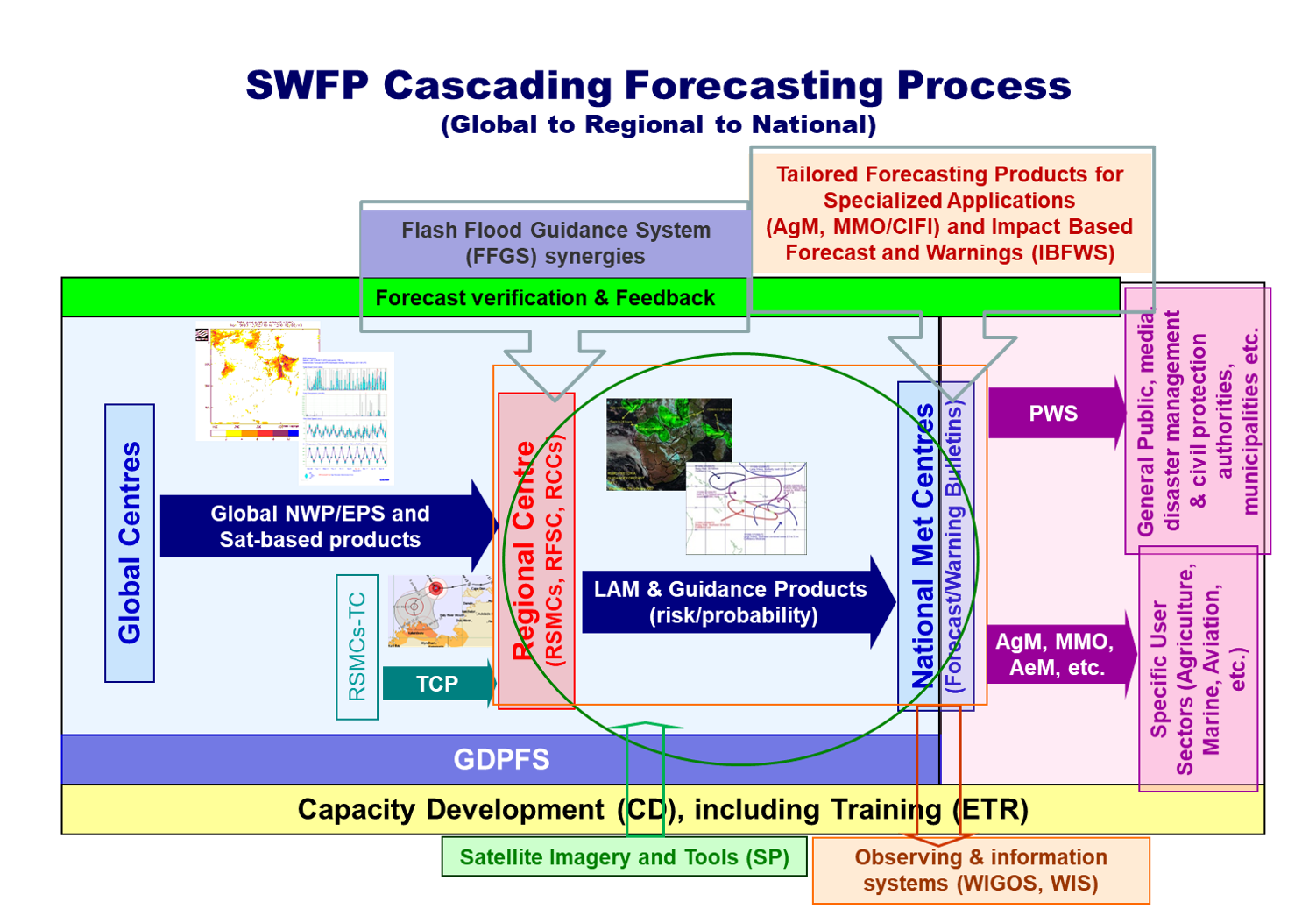SWFP 'Cascading Forecasting Process' and WMO Long-term Goals and Strategic Objectives to which SWFP contributes

SWFP was initially started as a 'demonstration' project (namely Severe Weather Forecasting Demonstration Project (SWFDP)) in 2006. The Eighteenth World Meteorological Congress (Cg-18, June 2019) through its Resolution 15 (Cg-18) decided, among others, to remove the 'demonstration' designation of SWFDP to refer it as Severe Weather Forecasting Programme (SWFP) in consideration of the fact that Project has demonstrated the capability of the cascading forecasting process. SWFP is primarily built on WMO Integrated Processing and Prediction System (WIPPS) (formerly GDPFS), in collaboration with other relevant WMO Programmes and activities including Public Weather Services (PWS) Programme. SWFP makes efficient use of the WIPPS centres by implementing and sustaining a “Cascading Forecasting Process” (global to regional, to national).
SWFP also engages other WMO programmes that concern the real-time prediction of hydro-meteorological hazards like Tropical Cyclone Programme (TCP) and Hydrology and Water Resources Programme (HWRP) including Flash Flood Guidance System (FFGS). SWFP through developing synergies and linkages with TCP, FFGS and other relevant initiatives also contributes to support MHEWS interoperable environment in various sub-regions like Southern Africa, South East Asia, South Asia and Central Asia etc. Since its inception, SWFP has proven to improve the lead-time and reliability for alerts and warnings about high-impact events such as heavy precipitation, strong winds and high waves. It has been strengthening engagement of NMHSs with users including disaster management and civil protection agencies, media and local communities for improved disaster risk reduction (DRR) and decision making process by users. The programme is benefiting to various socio-economic sectors as well, including agriculture, fisheries, aviation, and marine transportation. Currently, SWFP involves and benefits over 80 developing countries, LDCs and SIDS in nine sub-regions including Southern Africa, Eastern Africa, West Africa and Central Africa in RA I; South-East Asia, South Asia and Central Asia in RA II; Eastern Caribbean in RA IV, and South Pacific in RA V. SWFP is implemented with contributions from various WMCs/global NWP centres and RSMCs/regional centres, and support from several development partners and donors including governments. Subject to availability of resources, SWFP will be expanded to more geographical areas e.g. South America, North Africa and Southeastern Asia-Oceania to benefit more developing countries. WMO long-term goals & Strategic Objectives to which SWFP contributes SWFP has made contributions to the WMO Strategic Priorities for 2016-2019, especially in areas of DRR, GFCS (through climate change adaptation by building climate resilience) and Capacity Development. Now SWFP contributes to the overarching priorities and Long-term Goals for 2030 horizon and Strategic Objectives, focused on addressing the most pressing developments and needs during the 2020-2023 planning cycle of Organization as set out in the WMO Strategic Plan. SWFP mainly contributes to the following strategic objectives of the Organization:
Through above contributions and owing to its operational support to multi-hazard early warning services (MHEWS) at regional and national levels, SWFP aims to support the UN 2030 Agenda for Sustainable Development (Sustainable Development Goals) and the Sendai Framework for DRR 2015-2030. Legacy as a 'Demonstration Project' during 2006-2019 The first ever Severe Weather Forecasting Demonstration Project (SWFDP) was started in south-eastern Africa in 2006 with involvement of 5 countries (Botswana, Madagascar, Mozambique, United Republic of Tanzania & Zimbabwe) and with contributions from RSMC Pretoria (South Africa) to provide regional severe weather forecast guidance products and RSMC La Réunion (France) to provide tropical cyclone forecast support. The global centres of ECMWF, UK Met Office and US NOAA/NCEP contributed for NWP including EPS products, while EUMETSAT contributed for satellite information. In 2008, this subproject was expanded to all 16 countries in Southern Africa. The Fifteenth World Meteorological Congress (Cg-XV, 2007) noted the significant development and progress of the first SWFDP regional subproject, and decided that its concept should be expanded and implemented throughout RA I (Africa) and to other WMO Regions especially in developing countries. Subsequently, in later years the project was rolled out to several other sub-regions in the world.
Countries participating in SWFP are able to benefit from advances in the science of weather forecasting, especially the dramatic development in Numerical Weather Prediction (NWP) including Ensemble Prediction Systems (EPS) which give guidance to weather forecasters in advance of potential hazardous weather conditions for issuance of alerts and warnings.
|


